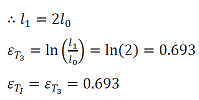Mechanical Engineering Exam > Mechanical Engineering Questions > By application of tensile force, the cross-s...
Start Learning for Free
By application of tensile force, the cross-sectional area of a bar P is first reduced by 30% and then by an additional 20% of initial original area. Another bar Q of the same material is reduced in cross-sectional area by 50% in a single step by applying tensile force. After deformation, the true strains in bar P and bar Q will respectively be
- a)0.50 and 0.50
- b)0.58 and 0.69
- c)0.69 and 0.69
- d)0.78 and 1.0
Correct answer is option 'C'. Can you explain this answer?
Most Upvoted Answer
By application of tensile force, the cross-sectional area of a bar P ...
**Bar P:**
- **Initial reduction:**
- Cross-sectional area reduced by 30%
- **Additional reduction:**
- Cross-sectional area reduced by 20% of initial original area
- **Total reduction:**
- 30% + (20% of initial area) = 30% + (20% * 70%) = 30% + 14% = 44%
- **True strain:**
- True strain = ln(1 + total reduction) = ln(1 + 0.44) ≈ 0.69
**Bar Q:**
- **Single step reduction:**
- Cross-sectional area reduced by 50%
- **True strain:**
- True strain = ln(1 + reduction) = ln(1 + 0.50) = 0.69
**Conclusion:**
- The true strains in bar P and bar Q after deformation will be approximately 0.69 for both bars.
- **Initial reduction:**
- Cross-sectional area reduced by 30%
- **Additional reduction:**
- Cross-sectional area reduced by 20% of initial original area
- **Total reduction:**
- 30% + (20% of initial area) = 30% + (20% * 70%) = 30% + 14% = 44%
- **True strain:**
- True strain = ln(1 + total reduction) = ln(1 + 0.44) ≈ 0.69
**Bar Q:**
- **Single step reduction:**
- Cross-sectional area reduced by 50%
- **True strain:**
- True strain = ln(1 + reduction) = ln(1 + 0.50) = 0.69
**Conclusion:**
- The true strains in bar P and bar Q after deformation will be approximately 0.69 for both bars.
Free Test
FREE
| Start Free Test |
Community Answer
By application of tensile force, the cross-sectional area of a bar P ...
Case-1: Bar P
A0L0 = A1L1 = A2L2
⇒ A1 = 0.7A0

A2 = 0.5A0
L2 = 2L0 = 2 x 0.7L1

Case-2: Bar Q
A0L0 = A1L1
⇒ A1 = 0.5A0


|
Explore Courses for Mechanical Engineering exam
|

|
By application of tensile force, the cross-sectional area of a bar P is first reduced by 30% and then by an additional 20% of initial original area. Another bar Q of the same material is reduced in cross-sectional area by 50% in a single step by applying tensile force. After deformation, the true strains in bar P and bar Q will respectively bea)0.50 and 0.50b)0.58 and 0.69c)0.69 and 0.69d)0.78 and 1.0Correct answer is option 'C'. Can you explain this answer?
Question Description
By application of tensile force, the cross-sectional area of a bar P is first reduced by 30% and then by an additional 20% of initial original area. Another bar Q of the same material is reduced in cross-sectional area by 50% in a single step by applying tensile force. After deformation, the true strains in bar P and bar Q will respectively bea)0.50 and 0.50b)0.58 and 0.69c)0.69 and 0.69d)0.78 and 1.0Correct answer is option 'C'. Can you explain this answer? for Mechanical Engineering 2025 is part of Mechanical Engineering preparation. The Question and answers have been prepared according to the Mechanical Engineering exam syllabus. Information about By application of tensile force, the cross-sectional area of a bar P is first reduced by 30% and then by an additional 20% of initial original area. Another bar Q of the same material is reduced in cross-sectional area by 50% in a single step by applying tensile force. After deformation, the true strains in bar P and bar Q will respectively bea)0.50 and 0.50b)0.58 and 0.69c)0.69 and 0.69d)0.78 and 1.0Correct answer is option 'C'. Can you explain this answer? covers all topics & solutions for Mechanical Engineering 2025 Exam. Find important definitions, questions, meanings, examples, exercises and tests below for By application of tensile force, the cross-sectional area of a bar P is first reduced by 30% and then by an additional 20% of initial original area. Another bar Q of the same material is reduced in cross-sectional area by 50% in a single step by applying tensile force. After deformation, the true strains in bar P and bar Q will respectively bea)0.50 and 0.50b)0.58 and 0.69c)0.69 and 0.69d)0.78 and 1.0Correct answer is option 'C'. Can you explain this answer?.
By application of tensile force, the cross-sectional area of a bar P is first reduced by 30% and then by an additional 20% of initial original area. Another bar Q of the same material is reduced in cross-sectional area by 50% in a single step by applying tensile force. After deformation, the true strains in bar P and bar Q will respectively bea)0.50 and 0.50b)0.58 and 0.69c)0.69 and 0.69d)0.78 and 1.0Correct answer is option 'C'. Can you explain this answer? for Mechanical Engineering 2025 is part of Mechanical Engineering preparation. The Question and answers have been prepared according to the Mechanical Engineering exam syllabus. Information about By application of tensile force, the cross-sectional area of a bar P is first reduced by 30% and then by an additional 20% of initial original area. Another bar Q of the same material is reduced in cross-sectional area by 50% in a single step by applying tensile force. After deformation, the true strains in bar P and bar Q will respectively bea)0.50 and 0.50b)0.58 and 0.69c)0.69 and 0.69d)0.78 and 1.0Correct answer is option 'C'. Can you explain this answer? covers all topics & solutions for Mechanical Engineering 2025 Exam. Find important definitions, questions, meanings, examples, exercises and tests below for By application of tensile force, the cross-sectional area of a bar P is first reduced by 30% and then by an additional 20% of initial original area. Another bar Q of the same material is reduced in cross-sectional area by 50% in a single step by applying tensile force. After deformation, the true strains in bar P and bar Q will respectively bea)0.50 and 0.50b)0.58 and 0.69c)0.69 and 0.69d)0.78 and 1.0Correct answer is option 'C'. Can you explain this answer?.
Solutions for By application of tensile force, the cross-sectional area of a bar P is first reduced by 30% and then by an additional 20% of initial original area. Another bar Q of the same material is reduced in cross-sectional area by 50% in a single step by applying tensile force. After deformation, the true strains in bar P and bar Q will respectively bea)0.50 and 0.50b)0.58 and 0.69c)0.69 and 0.69d)0.78 and 1.0Correct answer is option 'C'. Can you explain this answer? in English & in Hindi are available as part of our courses for Mechanical Engineering.
Download more important topics, notes, lectures and mock test series for Mechanical Engineering Exam by signing up for free.
Here you can find the meaning of By application of tensile force, the cross-sectional area of a bar P is first reduced by 30% and then by an additional 20% of initial original area. Another bar Q of the same material is reduced in cross-sectional area by 50% in a single step by applying tensile force. After deformation, the true strains in bar P and bar Q will respectively bea)0.50 and 0.50b)0.58 and 0.69c)0.69 and 0.69d)0.78 and 1.0Correct answer is option 'C'. Can you explain this answer? defined & explained in the simplest way possible. Besides giving the explanation of
By application of tensile force, the cross-sectional area of a bar P is first reduced by 30% and then by an additional 20% of initial original area. Another bar Q of the same material is reduced in cross-sectional area by 50% in a single step by applying tensile force. After deformation, the true strains in bar P and bar Q will respectively bea)0.50 and 0.50b)0.58 and 0.69c)0.69 and 0.69d)0.78 and 1.0Correct answer is option 'C'. Can you explain this answer?, a detailed solution for By application of tensile force, the cross-sectional area of a bar P is first reduced by 30% and then by an additional 20% of initial original area. Another bar Q of the same material is reduced in cross-sectional area by 50% in a single step by applying tensile force. After deformation, the true strains in bar P and bar Q will respectively bea)0.50 and 0.50b)0.58 and 0.69c)0.69 and 0.69d)0.78 and 1.0Correct answer is option 'C'. Can you explain this answer? has been provided alongside types of By application of tensile force, the cross-sectional area of a bar P is first reduced by 30% and then by an additional 20% of initial original area. Another bar Q of the same material is reduced in cross-sectional area by 50% in a single step by applying tensile force. After deformation, the true strains in bar P and bar Q will respectively bea)0.50 and 0.50b)0.58 and 0.69c)0.69 and 0.69d)0.78 and 1.0Correct answer is option 'C'. Can you explain this answer? theory, EduRev gives you an
ample number of questions to practice By application of tensile force, the cross-sectional area of a bar P is first reduced by 30% and then by an additional 20% of initial original area. Another bar Q of the same material is reduced in cross-sectional area by 50% in a single step by applying tensile force. After deformation, the true strains in bar P and bar Q will respectively bea)0.50 and 0.50b)0.58 and 0.69c)0.69 and 0.69d)0.78 and 1.0Correct answer is option 'C'. Can you explain this answer? tests, examples and also practice Mechanical Engineering tests.

|
Explore Courses for Mechanical Engineering exam
|

|
Signup for Free!
Signup to see your scores go up within 7 days! Learn & Practice with 1000+ FREE Notes, Videos & Tests.
























